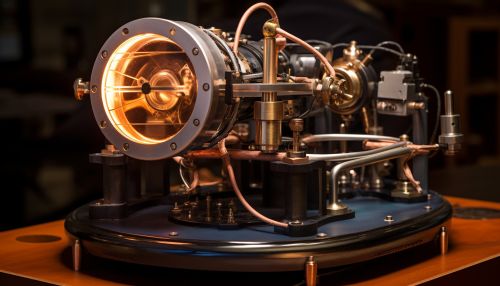Optomechanical Cooling
Introduction
Optomechanical cooling is a branch of quantum optics that explores the cooling of mechanical oscillators to their quantum ground state using light. This process is a key component in the development of quantum technologies, such as quantum computers and quantum sensors.


Theoretical Background
The theoretical basis for optomechanical cooling lies in the principles of quantum mechanics and the interaction of light with matter. The process relies on the quantum harmonic oscillator model, which describes the behavior of certain physical systems in quantum mechanics. The cooling effect is achieved through the interaction of the mechanical oscillator with a light field, typically in the form of a laser beam.
Optomechanical Systems
Optomechanical systems are physical setups that allow for the interaction between light and mechanical motion. These systems are typically composed of a mechanical oscillator, such as a vibrating mirror or a nanomechanical resonator, and a light source, such as a laser. The interaction between the light and the mechanical oscillator leads to a cooling effect, reducing the thermal motion of the oscillator and potentially bringing it to its quantum ground state.
Optomechanical Cooling Process
The process of optomechanical cooling involves the interaction of a mechanical oscillator with a light field. The light field exerts a radiation pressure force on the oscillator, which can lead to cooling or heating effects depending on the detuning of the light field.
In the cooling regime, the radiation pressure force damps the motion of the oscillator, reducing its thermal motion and potentially cooling it to its quantum ground state. This is achieved by detuning the light field to the red side of the mechanical resonance, which means that the frequency of the light field is lower than the natural frequency of the oscillator.
Applications
Optomechanical cooling has a wide range of potential applications in the field of quantum technology. It is a key technique in the development of quantum computers, where it can be used to cool the mechanical motion of quantum bits, or qubits, to their quantum ground state. This can improve the coherence and fidelity of quantum operations, leading to more reliable and efficient quantum computation.
In addition, optomechanical cooling can be used in quantum sensors to reduce thermal noise and improve the sensitivity of measurements. It can also be used in the study of quantum phenomena at macroscopic scales, such as quantum entanglement and quantum superposition.
Future Directions
While significant progress has been made in the field of optomechanical cooling, there are still many challenges to be overcome. One of the key challenges is the cooling of larger mechanical oscillators to their quantum ground state, which is a necessary step towards the realization of macroscopic quantum phenomena.
Furthermore, there is ongoing research into new materials and designs for optomechanical systems, with the aim of improving the efficiency and reliability of the cooling process. This includes the exploration of hybrid systems that combine optomechanical cooling with other cooling techniques, such as dilution refrigeration or laser cooling.
